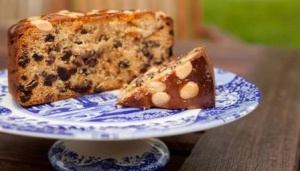Consultation launched for PGI status bid.
Dundee Cake is a step closer to having Protected Geographical Indicator (PGI) status after Scotland’s Food Secretary Richard Lochhead launched a national consultation today to consider the application.
The consultation will run for 12 weeks in line with the rules of the EU Protected Food Names (PFN) scheme, which was introduced in 1994 to protect food names on the basis of geographical or traditional recipes.
Dundee Cake is famously decorated with whole, blanched almonds and its distinctive recipe began development in the city in the late 1700’s. It is well known across the world, however does not currently enjoy PGI status and is produced in a number of various locations.
“Dundee is famous as a city of discoveries and we want the world to discover delicious, authentic Dundee Cake.
“We can trace its origins back hundreds of years to the kitchens of the marmalade inventor Janet Keiller, making it a thoroughly Dundonian delicacy which deserves European recognition for its unique characteristics and long associations with this city.
“Scotland is world-famous for our wonderful food and drink, and people want to know they are buying the real deal. Achieving PGI status for Dundee Cake will ensure that consumers at home and abroad have a one hundred per cent guarantee of the product’s authenticity.
“We already have Scottish foods, such as Stornoway Black Pudding and Scotch Beef, which are PGI protected and free from imitation. It guarantees the food’s provenance and supports local producers.
“The PFN scheme can benefit producers of brands synonymous with Scotland by providing them with recognition of their product and safeguarding it from imitation, and I would encourage them to look at taking this forward.”
Martin Goodfellow of local bakers Goodfellow & Steven, and himself a past deacon of the Baker Trade, said:
“Dundee Cake has become so far removed from its roots that it has almost become a catch all term for any fruit cake with peel and almonds in it. That is not the origin of the cake, nor is it the way it has been made in the city for over one hundred years. It is time we took back what is our own! To this end, we have had fantastic support from both Dundee Council and the Scottish Government and have built up a strong case for consideration.”
Dundee City Development Convener Councillor Will Dawson said:
“Dundee Cake is one of the city’s most famous delicacies and an important part of our history. It’s only right that we work towards getting protected status for this much loved cake.”
The Dundee Cake consultation can be accessed via: http://www.scotland.gov.uk/Publications/2014/11/7264
On behalf of the Scottish Government, Scotland’s Rural College (SRUC) has been working with experts from Abertay University and Dundee bakers to agree a specification and application to apply for Dundee Cake to be registered under the EC Protected Food Name (PFN) Scheme under the Protection of Geographical Indication (PGI) designation.
The application for Dundee Cake PGI status outlines the raw materials and volumes that must be used to make Dundee Cake and specifies that the cake must be mixed, baked and decorated with almonds in the Dundee specific area.
Parties who wish to comment/object must state their intention to do so within four weeks of the consultation launch. They will then have a further eight weeks to give complete details of their comments/objections.
Once the consultation has been completed, the application will be forwarded to Defra, which is responsible for submitting applications from the UK to the European Commission. It takes, on average, two years for an application for receive approval, although new regulations introduced in 2013 aim to reduce this timescale to one year.
More on the PFN scheme: http://www.scotland.gov.uk/Topics/Business-Industry/Food-Industry/national-strategy/rep/PFNs
Dundee Cake has an iconic appearance, in that the carefully laid-out pattern of whole, blanched almonds immediately distinguishes it from other fruit cakes. It is light and buttery containing sultanas, almonds, Amontillado sherry and candied orange peel. It is a fruit cake made by the creaming method, the mixture contains about 25% more flour than normally expected and contains sugar with dried vine fruits, candied peel and chopped almonds, and the cake is flavoured with grated orange zest.
An early version of a Dundee Cake was developed in the late 1700’s under the roof of Janet Keiller’s shop. Janet Keiller’s invention of a new type of Seville orange marmalade launched the family into large-scale commercial production. Around the mid 1800’s the factory began experimenting the idea of a special Keiller cake as a useful, non-seasonal item in the company’s production schedule. The recipe later became established as Keiller’s Dundee Cake and has continued to be made in the traditional style by members of the Baker Trade Of Dundee, which is heading the proposal.






